Marketing of KiwiRail New Zealand Discussion 2022
VerifiedAdded on 2022/09/17
|19
|4722
|21
AI Summary
Contribute Materials
Your contribution can guide someone’s learning journey. Share your
documents today.
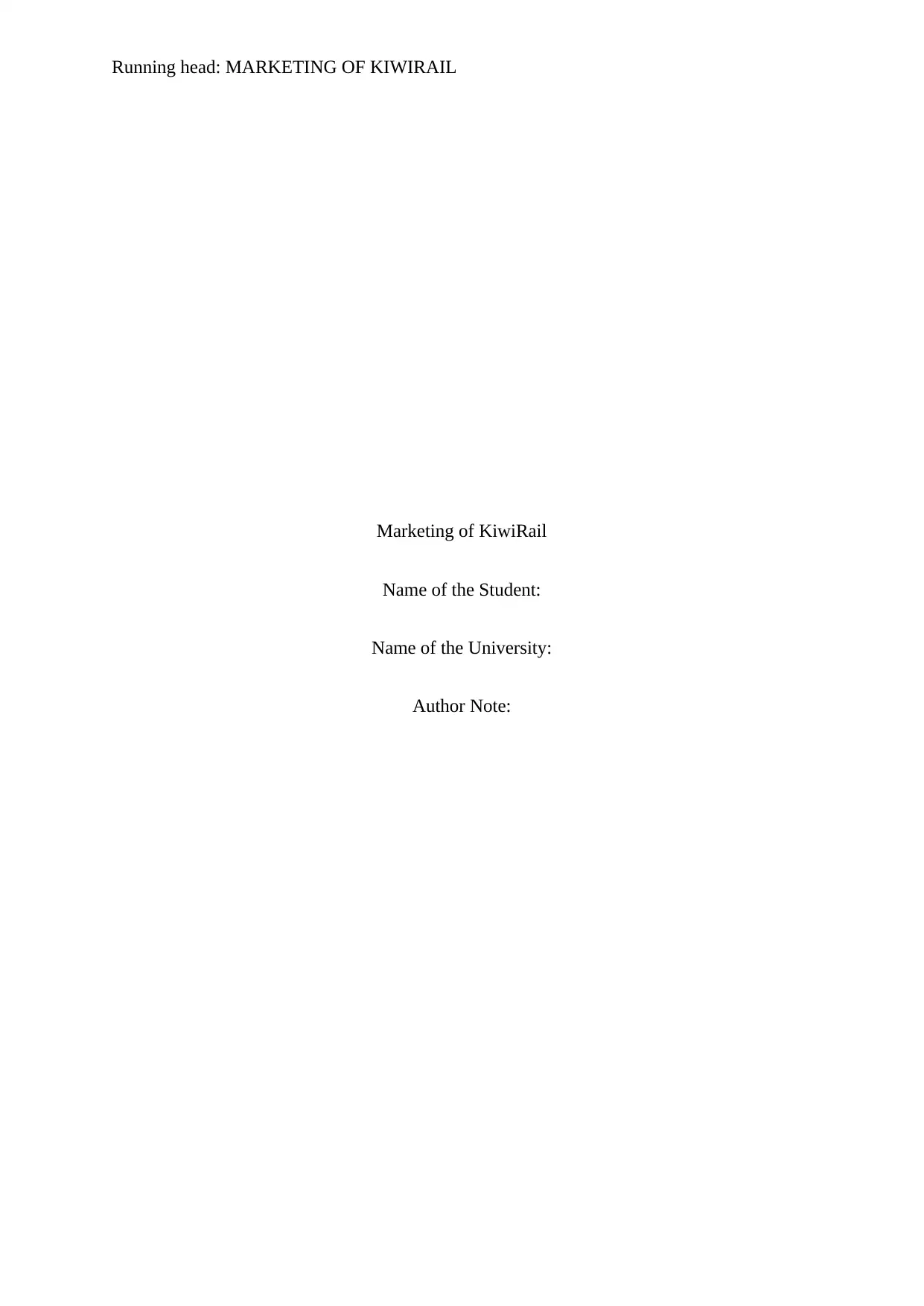
Running head: MARKETING OF KIWIRAIL
Marketing of KiwiRail
Name of the Student:
Name of the University:
Author Note:
Marketing of KiwiRail
Name of the Student:
Name of the University:
Author Note:
Secure Best Marks with AI Grader
Need help grading? Try our AI Grader for instant feedback on your assignments.
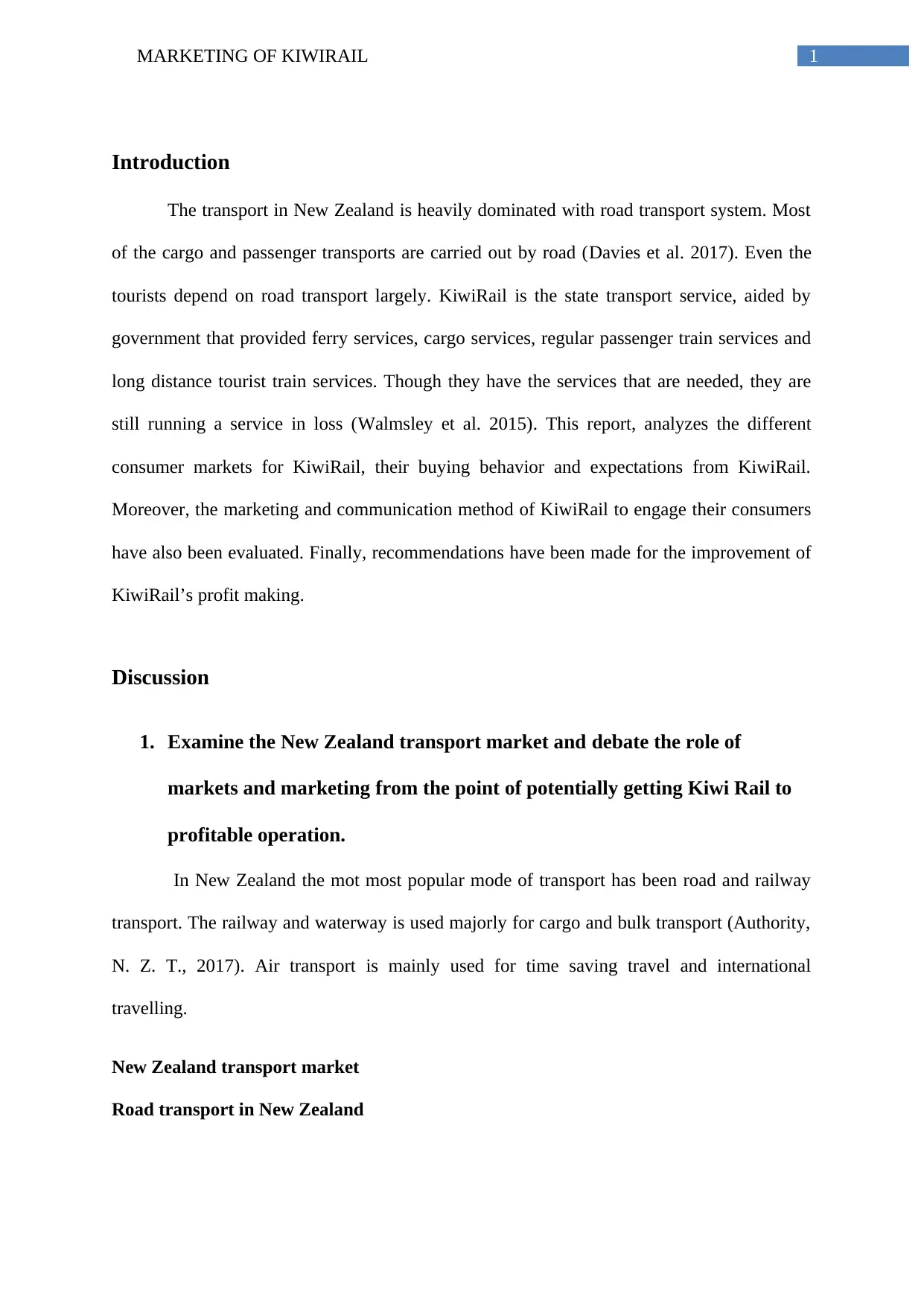
1MARKETING OF KIWIRAIL
Introduction
The transport in New Zealand is heavily dominated with road transport system. Most
of the cargo and passenger transports are carried out by road (Davies et al. 2017). Even the
tourists depend on road transport largely. KiwiRail is the state transport service, aided by
government that provided ferry services, cargo services, regular passenger train services and
long distance tourist train services. Though they have the services that are needed, they are
still running a service in loss (Walmsley et al. 2015). This report, analyzes the different
consumer markets for KiwiRail, their buying behavior and expectations from KiwiRail.
Moreover, the marketing and communication method of KiwiRail to engage their consumers
have also been evaluated. Finally, recommendations have been made for the improvement of
KiwiRail’s profit making.
Discussion
1. Examine the New Zealand transport market and debate the role of
markets and marketing from the point of potentially getting Kiwi Rail to
profitable operation.
In New Zealand the mot most popular mode of transport has been road and railway
transport. The railway and waterway is used majorly for cargo and bulk transport (Authority,
N. Z. T., 2017). Air transport is mainly used for time saving travel and international
travelling.
New Zealand transport market
Road transport in New Zealand
Introduction
The transport in New Zealand is heavily dominated with road transport system. Most
of the cargo and passenger transports are carried out by road (Davies et al. 2017). Even the
tourists depend on road transport largely. KiwiRail is the state transport service, aided by
government that provided ferry services, cargo services, regular passenger train services and
long distance tourist train services. Though they have the services that are needed, they are
still running a service in loss (Walmsley et al. 2015). This report, analyzes the different
consumer markets for KiwiRail, their buying behavior and expectations from KiwiRail.
Moreover, the marketing and communication method of KiwiRail to engage their consumers
have also been evaluated. Finally, recommendations have been made for the improvement of
KiwiRail’s profit making.
Discussion
1. Examine the New Zealand transport market and debate the role of
markets and marketing from the point of potentially getting Kiwi Rail to
profitable operation.
In New Zealand the mot most popular mode of transport has been road and railway
transport. The railway and waterway is used majorly for cargo and bulk transport (Authority,
N. Z. T., 2017). Air transport is mainly used for time saving travel and international
travelling.
New Zealand transport market
Road transport in New Zealand
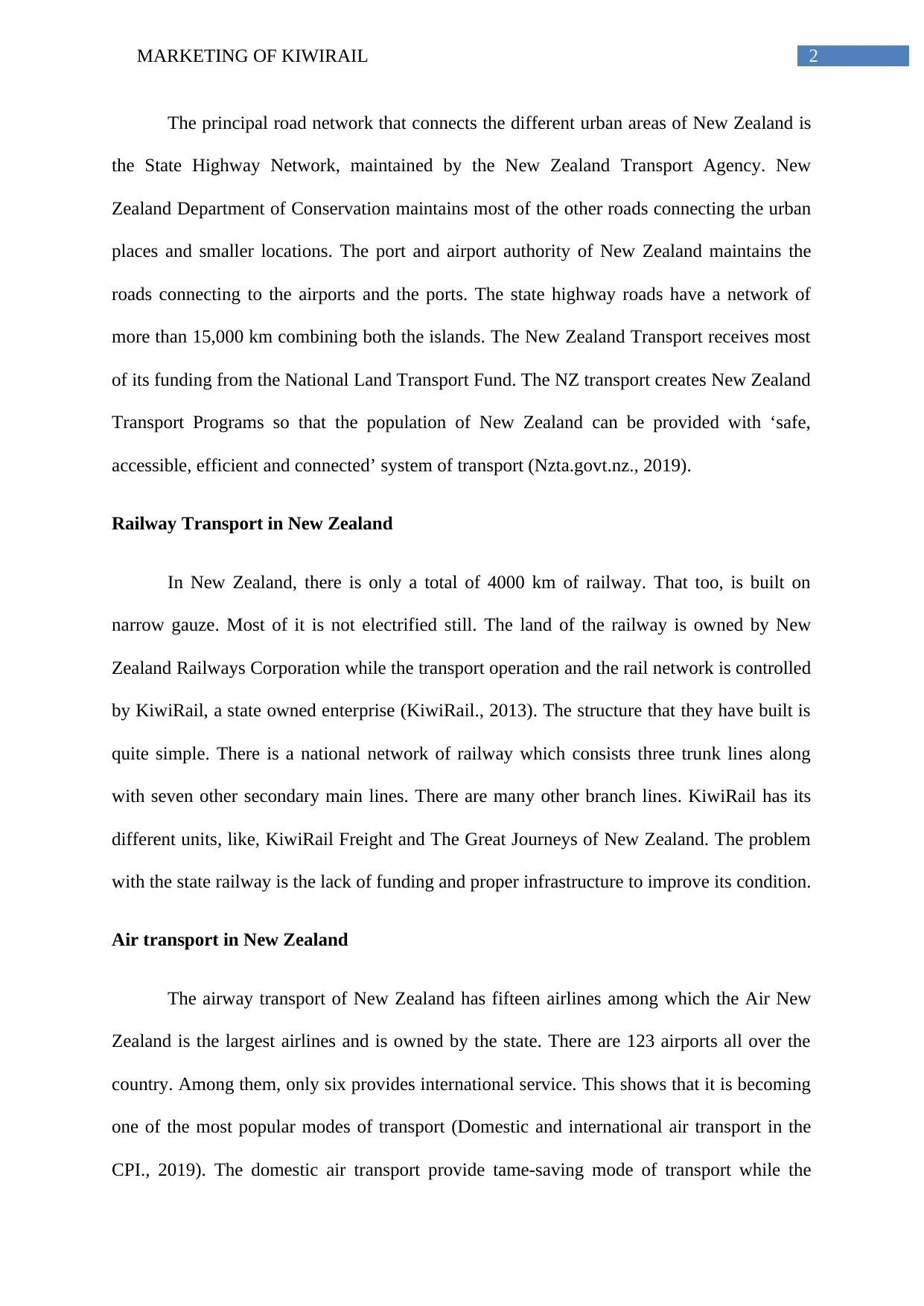
2MARKETING OF KIWIRAIL
The principal road network that connects the different urban areas of New Zealand is
the State Highway Network, maintained by the New Zealand Transport Agency. New
Zealand Department of Conservation maintains most of the other roads connecting the urban
places and smaller locations. The port and airport authority of New Zealand maintains the
roads connecting to the airports and the ports. The state highway roads have a network of
more than 15,000 km combining both the islands. The New Zealand Transport receives most
of its funding from the National Land Transport Fund. The NZ transport creates New Zealand
Transport Programs so that the population of New Zealand can be provided with ‘safe,
accessible, efficient and connected’ system of transport (Nzta.govt.nz., 2019).
Railway Transport in New Zealand
In New Zealand, there is only a total of 4000 km of railway. That too, is built on
narrow gauze. Most of it is not electrified still. The land of the railway is owned by New
Zealand Railways Corporation while the transport operation and the rail network is controlled
by KiwiRail, a state owned enterprise (KiwiRail., 2013). The structure that they have built is
quite simple. There is a national network of railway which consists three trunk lines along
with seven other secondary main lines. There are many other branch lines. KiwiRail has its
different units, like, KiwiRail Freight and The Great Journeys of New Zealand. The problem
with the state railway is the lack of funding and proper infrastructure to improve its condition.
Air transport in New Zealand
The airway transport of New Zealand has fifteen airlines among which the Air New
Zealand is the largest airlines and is owned by the state. There are 123 airports all over the
country. Among them, only six provides international service. This shows that it is becoming
one of the most popular modes of transport (Domestic and international air transport in the
CPI., 2019). The domestic air transport provide tame-saving mode of transport while the
The principal road network that connects the different urban areas of New Zealand is
the State Highway Network, maintained by the New Zealand Transport Agency. New
Zealand Department of Conservation maintains most of the other roads connecting the urban
places and smaller locations. The port and airport authority of New Zealand maintains the
roads connecting to the airports and the ports. The state highway roads have a network of
more than 15,000 km combining both the islands. The New Zealand Transport receives most
of its funding from the National Land Transport Fund. The NZ transport creates New Zealand
Transport Programs so that the population of New Zealand can be provided with ‘safe,
accessible, efficient and connected’ system of transport (Nzta.govt.nz., 2019).
Railway Transport in New Zealand
In New Zealand, there is only a total of 4000 km of railway. That too, is built on
narrow gauze. Most of it is not electrified still. The land of the railway is owned by New
Zealand Railways Corporation while the transport operation and the rail network is controlled
by KiwiRail, a state owned enterprise (KiwiRail., 2013). The structure that they have built is
quite simple. There is a national network of railway which consists three trunk lines along
with seven other secondary main lines. There are many other branch lines. KiwiRail has its
different units, like, KiwiRail Freight and The Great Journeys of New Zealand. The problem
with the state railway is the lack of funding and proper infrastructure to improve its condition.
Air transport in New Zealand
The airway transport of New Zealand has fifteen airlines among which the Air New
Zealand is the largest airlines and is owned by the state. There are 123 airports all over the
country. Among them, only six provides international service. This shows that it is becoming
one of the most popular modes of transport (Domestic and international air transport in the
CPI., 2019). The domestic air transport provide tame-saving mode of transport while the
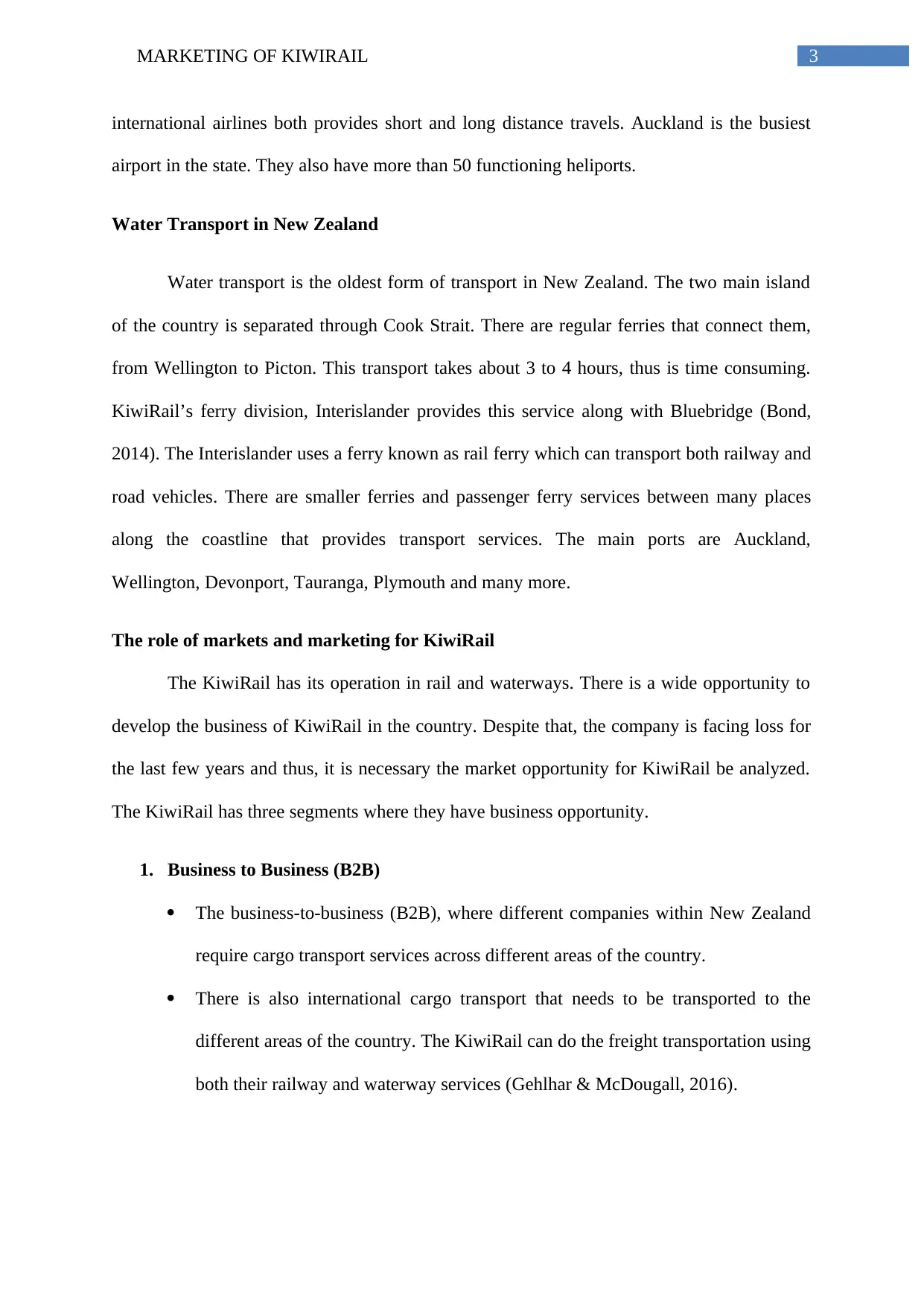
3MARKETING OF KIWIRAIL
international airlines both provides short and long distance travels. Auckland is the busiest
airport in the state. They also have more than 50 functioning heliports.
Water Transport in New Zealand
Water transport is the oldest form of transport in New Zealand. The two main island
of the country is separated through Cook Strait. There are regular ferries that connect them,
from Wellington to Picton. This transport takes about 3 to 4 hours, thus is time consuming.
KiwiRail’s ferry division, Interislander provides this service along with Bluebridge (Bond,
2014). The Interislander uses a ferry known as rail ferry which can transport both railway and
road vehicles. There are smaller ferries and passenger ferry services between many places
along the coastline that provides transport services. The main ports are Auckland,
Wellington, Devonport, Tauranga, Plymouth and many more.
The role of markets and marketing for KiwiRail
The KiwiRail has its operation in rail and waterways. There is a wide opportunity to
develop the business of KiwiRail in the country. Despite that, the company is facing loss for
the last few years and thus, it is necessary the market opportunity for KiwiRail be analyzed.
The KiwiRail has three segments where they have business opportunity.
1. Business to Business (B2B)
The business-to-business (B2B), where different companies within New Zealand
require cargo transport services across different areas of the country.
There is also international cargo transport that needs to be transported to the
different areas of the country. The KiwiRail can do the freight transportation using
both their railway and waterway services (Gehlhar & McDougall, 2016).
international airlines both provides short and long distance travels. Auckland is the busiest
airport in the state. They also have more than 50 functioning heliports.
Water Transport in New Zealand
Water transport is the oldest form of transport in New Zealand. The two main island
of the country is separated through Cook Strait. There are regular ferries that connect them,
from Wellington to Picton. This transport takes about 3 to 4 hours, thus is time consuming.
KiwiRail’s ferry division, Interislander provides this service along with Bluebridge (Bond,
2014). The Interislander uses a ferry known as rail ferry which can transport both railway and
road vehicles. There are smaller ferries and passenger ferry services between many places
along the coastline that provides transport services. The main ports are Auckland,
Wellington, Devonport, Tauranga, Plymouth and many more.
The role of markets and marketing for KiwiRail
The KiwiRail has its operation in rail and waterways. There is a wide opportunity to
develop the business of KiwiRail in the country. Despite that, the company is facing loss for
the last few years and thus, it is necessary the market opportunity for KiwiRail be analyzed.
The KiwiRail has three segments where they have business opportunity.
1. Business to Business (B2B)
The business-to-business (B2B), where different companies within New Zealand
require cargo transport services across different areas of the country.
There is also international cargo transport that needs to be transported to the
different areas of the country. The KiwiRail can do the freight transportation using
both their railway and waterway services (Gehlhar & McDougall, 2016).
Secure Best Marks with AI Grader
Need help grading? Try our AI Grader for instant feedback on your assignments.

4MARKETING OF KIWIRAIL
2. Business to Customer (B2C)
The business to customer (B2C), have people all around the country traveling to
different parts and the passengers traveling within and across the major cities.
There are also tourists that come every year to travel and for that, travel trains can
be made available (Heatley, 2011).
3. Business to Government (B2G)
Moreover, there is also a business to government market for KiwiRail.
Government agencies also use the service of the organization for direct as well as
indirect purposes.
The government has also made sizable investment in the company though the
company has not been able to make much profit.
Importance of different markets
The three different markets, B2B, B2C and B2G are important for Kiwi Rail.
1. B2B
The B2B market promises the most profit as this market will use their services for
business purposes.
Moreover, the international transports can incur foreign currency and can turn the
business of KiwiRail into profitability (Zealand, 2014).
2. B2C
The B2C market is the most important market of KiwiRail. The highest number of
customers lies in this sector.
Though most of them use private transport for short distance travels, they still
need trains for long distance transport.
2. Business to Customer (B2C)
The business to customer (B2C), have people all around the country traveling to
different parts and the passengers traveling within and across the major cities.
There are also tourists that come every year to travel and for that, travel trains can
be made available (Heatley, 2011).
3. Business to Government (B2G)
Moreover, there is also a business to government market for KiwiRail.
Government agencies also use the service of the organization for direct as well as
indirect purposes.
The government has also made sizable investment in the company though the
company has not been able to make much profit.
Importance of different markets
The three different markets, B2B, B2C and B2G are important for Kiwi Rail.
1. B2B
The B2B market promises the most profit as this market will use their services for
business purposes.
Moreover, the international transports can incur foreign currency and can turn the
business of KiwiRail into profitability (Zealand, 2014).
2. B2C
The B2C market is the most important market of KiwiRail. The highest number of
customers lies in this sector.
Though most of them use private transport for short distance travels, they still
need trains for long distance transport.

5MARKETING OF KIWIRAIL
Moreover, the airfare for domestic travel is quite high. Their service is customer
centric.
3. B2G
The B2G market is important for KiwiRail, as KiwiRail will profit larger through
them.
The government tries continuously to attract tourists from all over the world.
Through them KiwiRail will procure much profit as they already have the correct
product and place.
Target Considerations
Utilizing all these market is extremely necessary for KiwiRail. In order to comeback
in profitable business, it is necessary that the company increase their consumers.
1. B2B
In the B2B market, KiwiRail should consider the inland and international ferries
as well the cross-island trains as with it the company can gain much profit
(Chowdhury, Ceder & Schwalger, 2015).
2. B2C
In the B2C market, KiwiRail should consider providing cheaper means of
transport with standard facilities, in order to attract more end customers.
Along with that, the tourist trains are a promising source of income (New Zealand
Transport System | New Zealand Now., 2019).
The B2B market opportunity not only enables the company to increase their
consumers but also reduce operational costs.
Moreover, the airfare for domestic travel is quite high. Their service is customer
centric.
3. B2G
The B2G market is important for KiwiRail, as KiwiRail will profit larger through
them.
The government tries continuously to attract tourists from all over the world.
Through them KiwiRail will procure much profit as they already have the correct
product and place.
Target Considerations
Utilizing all these market is extremely necessary for KiwiRail. In order to comeback
in profitable business, it is necessary that the company increase their consumers.
1. B2B
In the B2B market, KiwiRail should consider the inland and international ferries
as well the cross-island trains as with it the company can gain much profit
(Chowdhury, Ceder & Schwalger, 2015).
2. B2C
In the B2C market, KiwiRail should consider providing cheaper means of
transport with standard facilities, in order to attract more end customers.
Along with that, the tourist trains are a promising source of income (New Zealand
Transport System | New Zealand Now., 2019).
The B2B market opportunity not only enables the company to increase their
consumers but also reduce operational costs.
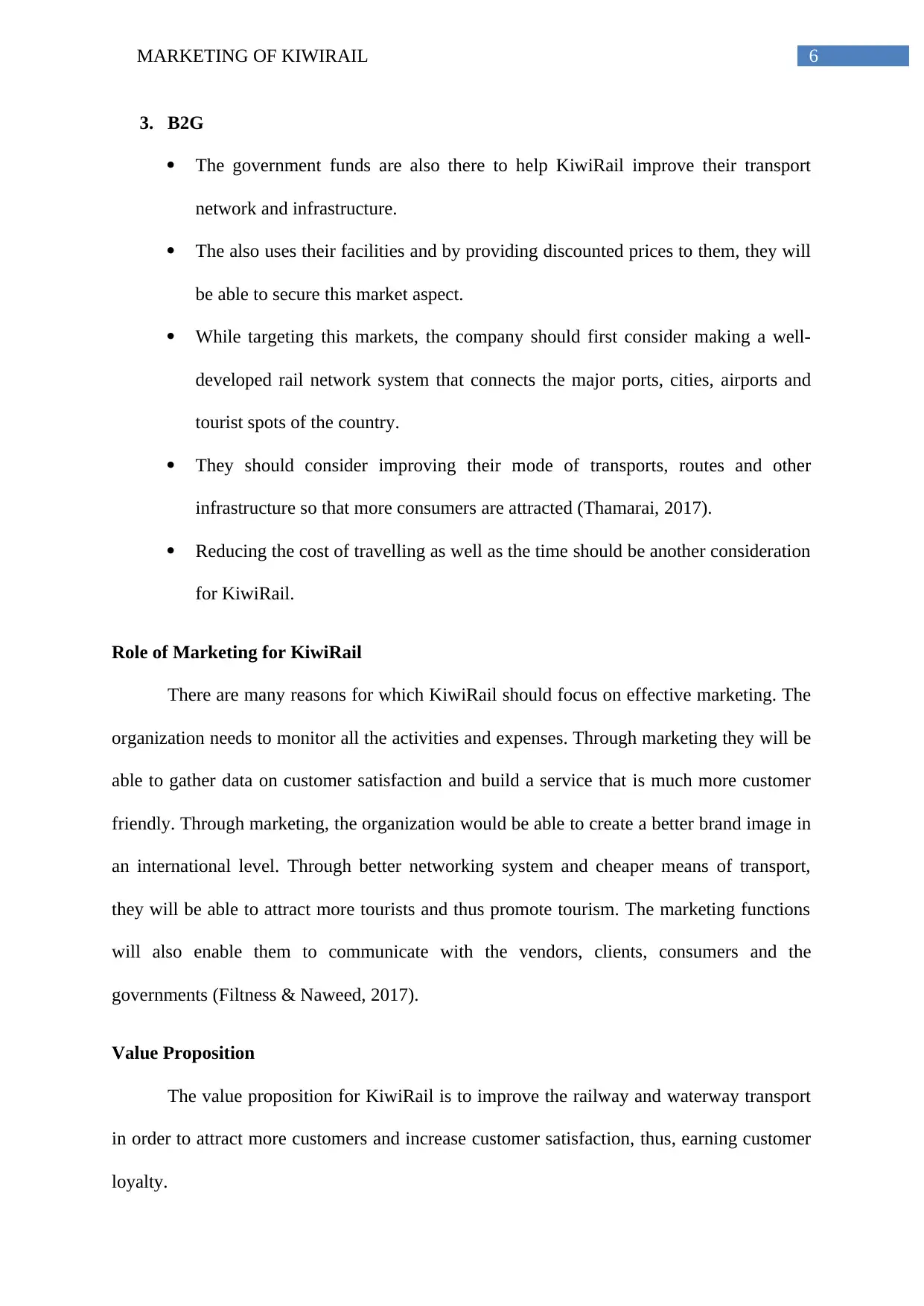
6MARKETING OF KIWIRAIL
3. B2G
The government funds are also there to help KiwiRail improve their transport
network and infrastructure.
The also uses their facilities and by providing discounted prices to them, they will
be able to secure this market aspect.
While targeting this markets, the company should first consider making a well-
developed rail network system that connects the major ports, cities, airports and
tourist spots of the country.
They should consider improving their mode of transports, routes and other
infrastructure so that more consumers are attracted (Thamarai, 2017).
Reducing the cost of travelling as well as the time should be another consideration
for KiwiRail.
Role of Marketing for KiwiRail
There are many reasons for which KiwiRail should focus on effective marketing. The
organization needs to monitor all the activities and expenses. Through marketing they will be
able to gather data on customer satisfaction and build a service that is much more customer
friendly. Through marketing, the organization would be able to create a better brand image in
an international level. Through better networking system and cheaper means of transport,
they will be able to attract more tourists and thus promote tourism. The marketing functions
will also enable them to communicate with the vendors, clients, consumers and the
governments (Filtness & Naweed, 2017).
Value Proposition
The value proposition for KiwiRail is to improve the railway and waterway transport
in order to attract more customers and increase customer satisfaction, thus, earning customer
loyalty.
3. B2G
The government funds are also there to help KiwiRail improve their transport
network and infrastructure.
The also uses their facilities and by providing discounted prices to them, they will
be able to secure this market aspect.
While targeting this markets, the company should first consider making a well-
developed rail network system that connects the major ports, cities, airports and
tourist spots of the country.
They should consider improving their mode of transports, routes and other
infrastructure so that more consumers are attracted (Thamarai, 2017).
Reducing the cost of travelling as well as the time should be another consideration
for KiwiRail.
Role of Marketing for KiwiRail
There are many reasons for which KiwiRail should focus on effective marketing. The
organization needs to monitor all the activities and expenses. Through marketing they will be
able to gather data on customer satisfaction and build a service that is much more customer
friendly. Through marketing, the organization would be able to create a better brand image in
an international level. Through better networking system and cheaper means of transport,
they will be able to attract more tourists and thus promote tourism. The marketing functions
will also enable them to communicate with the vendors, clients, consumers and the
governments (Filtness & Naweed, 2017).
Value Proposition
The value proposition for KiwiRail is to improve the railway and waterway transport
in order to attract more customers and increase customer satisfaction, thus, earning customer
loyalty.
Paraphrase This Document
Need a fresh take? Get an instant paraphrase of this document with our AI Paraphraser
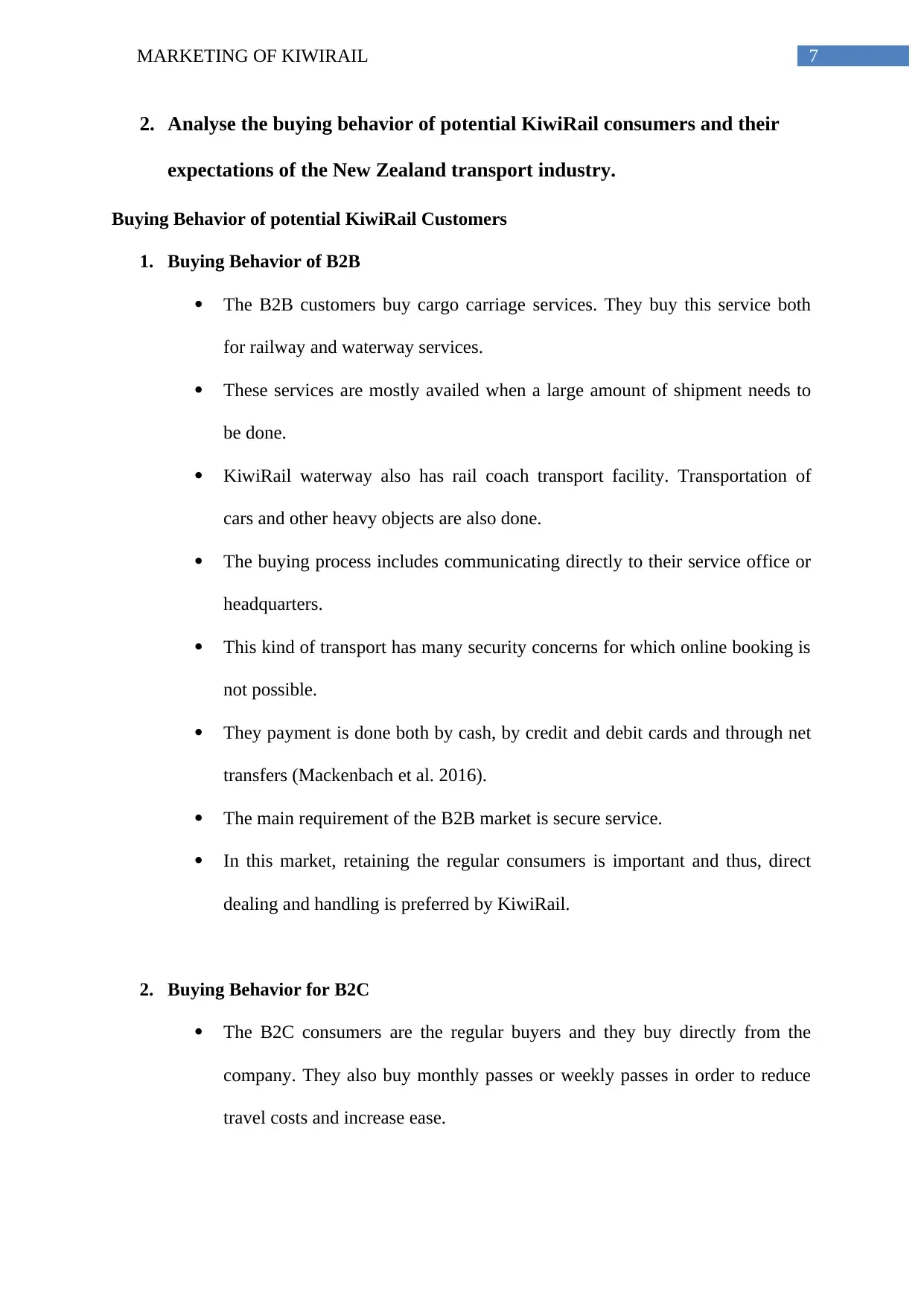
7MARKETING OF KIWIRAIL
2. Analyse the buying behavior of potential KiwiRail consumers and their
expectations of the New Zealand transport industry.
Buying Behavior of potential KiwiRail Customers
1. Buying Behavior of B2B
The B2B customers buy cargo carriage services. They buy this service both
for railway and waterway services.
These services are mostly availed when a large amount of shipment needs to
be done.
KiwiRail waterway also has rail coach transport facility. Transportation of
cars and other heavy objects are also done.
The buying process includes communicating directly to their service office or
headquarters.
This kind of transport has many security concerns for which online booking is
not possible.
They payment is done both by cash, by credit and debit cards and through net
transfers (Mackenbach et al. 2016).
The main requirement of the B2B market is secure service.
In this market, retaining the regular consumers is important and thus, direct
dealing and handling is preferred by KiwiRail.
2. Buying Behavior for B2C
The B2C consumers are the regular buyers and they buy directly from the
company. They also buy monthly passes or weekly passes in order to reduce
travel costs and increase ease.
2. Analyse the buying behavior of potential KiwiRail consumers and their
expectations of the New Zealand transport industry.
Buying Behavior of potential KiwiRail Customers
1. Buying Behavior of B2B
The B2B customers buy cargo carriage services. They buy this service both
for railway and waterway services.
These services are mostly availed when a large amount of shipment needs to
be done.
KiwiRail waterway also has rail coach transport facility. Transportation of
cars and other heavy objects are also done.
The buying process includes communicating directly to their service office or
headquarters.
This kind of transport has many security concerns for which online booking is
not possible.
They payment is done both by cash, by credit and debit cards and through net
transfers (Mackenbach et al. 2016).
The main requirement of the B2B market is secure service.
In this market, retaining the regular consumers is important and thus, direct
dealing and handling is preferred by KiwiRail.
2. Buying Behavior for B2C
The B2C consumers are the regular buyers and they buy directly from the
company. They also buy monthly passes or weekly passes in order to reduce
travel costs and increase ease.
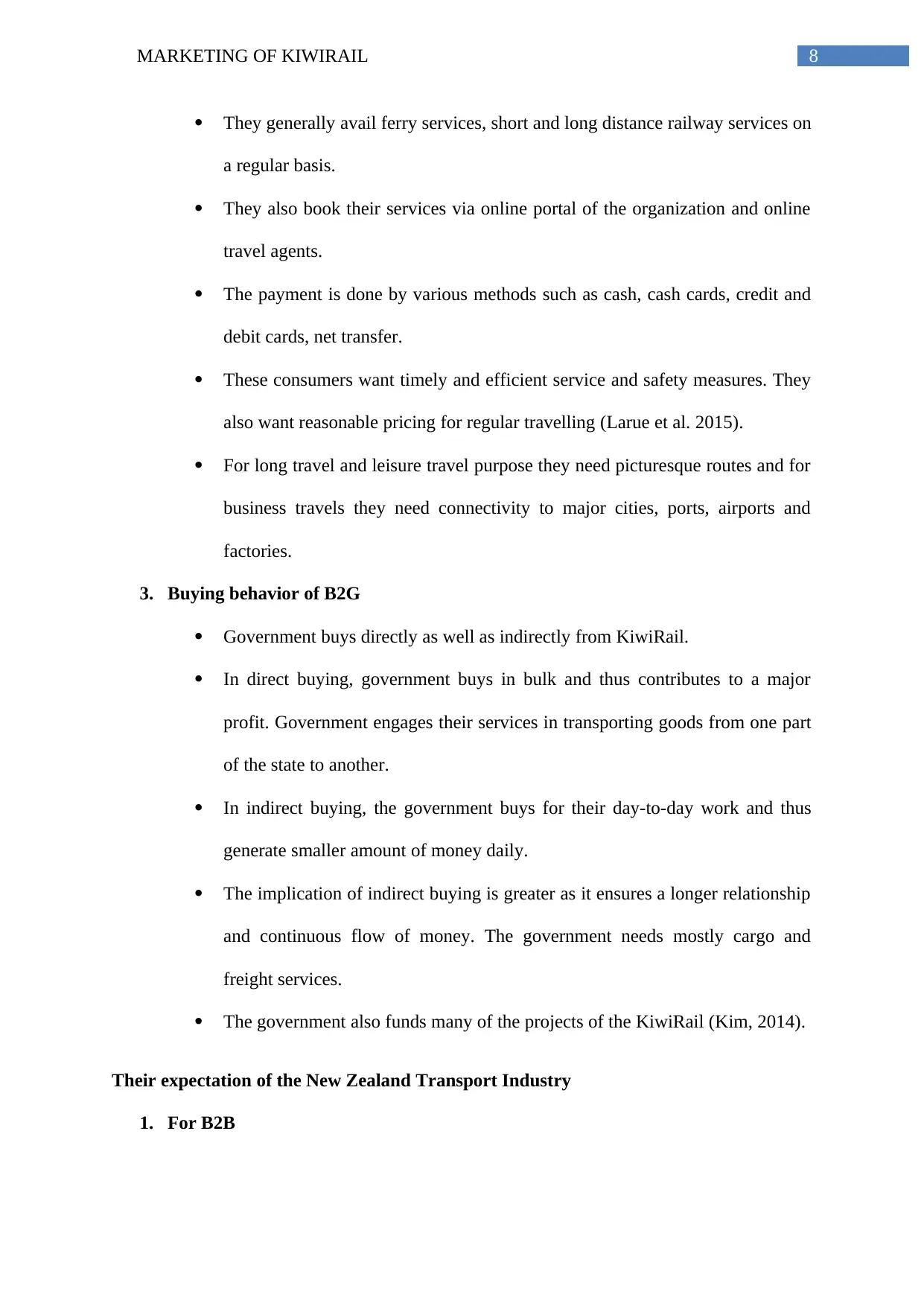
8MARKETING OF KIWIRAIL
They generally avail ferry services, short and long distance railway services on
a regular basis.
They also book their services via online portal of the organization and online
travel agents.
The payment is done by various methods such as cash, cash cards, credit and
debit cards, net transfer.
These consumers want timely and efficient service and safety measures. They
also want reasonable pricing for regular travelling (Larue et al. 2015).
For long travel and leisure travel purpose they need picturesque routes and for
business travels they need connectivity to major cities, ports, airports and
factories.
3. Buying behavior of B2G
Government buys directly as well as indirectly from KiwiRail.
In direct buying, government buys in bulk and thus contributes to a major
profit. Government engages their services in transporting goods from one part
of the state to another.
In indirect buying, the government buys for their day-to-day work and thus
generate smaller amount of money daily.
The implication of indirect buying is greater as it ensures a longer relationship
and continuous flow of money. The government needs mostly cargo and
freight services.
The government also funds many of the projects of the KiwiRail (Kim, 2014).
Their expectation of the New Zealand Transport Industry
1. For B2B
They generally avail ferry services, short and long distance railway services on
a regular basis.
They also book their services via online portal of the organization and online
travel agents.
The payment is done by various methods such as cash, cash cards, credit and
debit cards, net transfer.
These consumers want timely and efficient service and safety measures. They
also want reasonable pricing for regular travelling (Larue et al. 2015).
For long travel and leisure travel purpose they need picturesque routes and for
business travels they need connectivity to major cities, ports, airports and
factories.
3. Buying behavior of B2G
Government buys directly as well as indirectly from KiwiRail.
In direct buying, government buys in bulk and thus contributes to a major
profit. Government engages their services in transporting goods from one part
of the state to another.
In indirect buying, the government buys for their day-to-day work and thus
generate smaller amount of money daily.
The implication of indirect buying is greater as it ensures a longer relationship
and continuous flow of money. The government needs mostly cargo and
freight services.
The government also funds many of the projects of the KiwiRail (Kim, 2014).
Their expectation of the New Zealand Transport Industry
1. For B2B
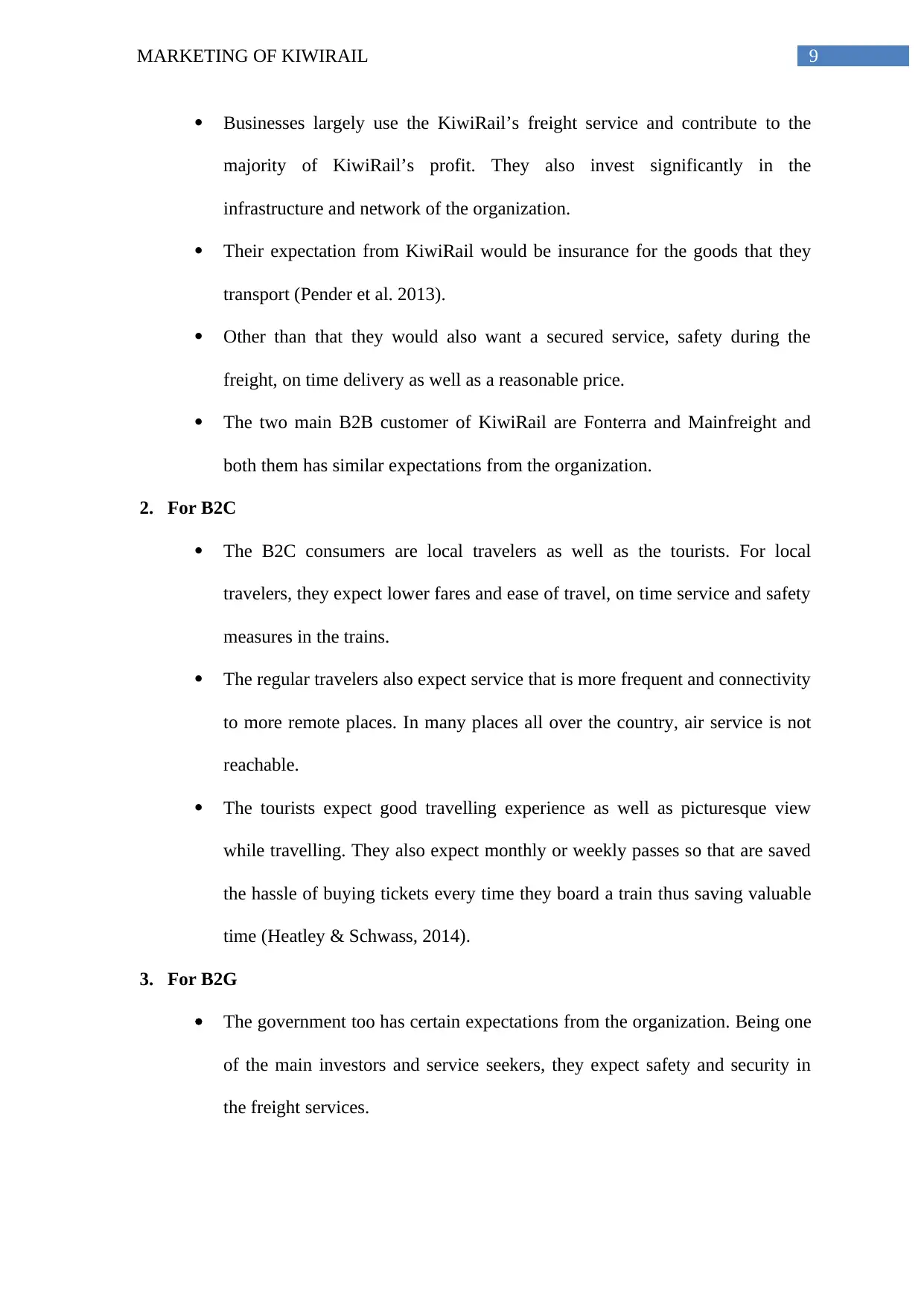
9MARKETING OF KIWIRAIL
Businesses largely use the KiwiRail’s freight service and contribute to the
majority of KiwiRail’s profit. They also invest significantly in the
infrastructure and network of the organization.
Their expectation from KiwiRail would be insurance for the goods that they
transport (Pender et al. 2013).
Other than that they would also want a secured service, safety during the
freight, on time delivery as well as a reasonable price.
The two main B2B customer of KiwiRail are Fonterra and Mainfreight and
both them has similar expectations from the organization.
2. For B2C
The B2C consumers are local travelers as well as the tourists. For local
travelers, they expect lower fares and ease of travel, on time service and safety
measures in the trains.
The regular travelers also expect service that is more frequent and connectivity
to more remote places. In many places all over the country, air service is not
reachable.
The tourists expect good travelling experience as well as picturesque view
while travelling. They also expect monthly or weekly passes so that are saved
the hassle of buying tickets every time they board a train thus saving valuable
time (Heatley & Schwass, 2014).
3. For B2G
The government too has certain expectations from the organization. Being one
of the main investors and service seekers, they expect safety and security in
the freight services.
Businesses largely use the KiwiRail’s freight service and contribute to the
majority of KiwiRail’s profit. They also invest significantly in the
infrastructure and network of the organization.
Their expectation from KiwiRail would be insurance for the goods that they
transport (Pender et al. 2013).
Other than that they would also want a secured service, safety during the
freight, on time delivery as well as a reasonable price.
The two main B2B customer of KiwiRail are Fonterra and Mainfreight and
both them has similar expectations from the organization.
2. For B2C
The B2C consumers are local travelers as well as the tourists. For local
travelers, they expect lower fares and ease of travel, on time service and safety
measures in the trains.
The regular travelers also expect service that is more frequent and connectivity
to more remote places. In many places all over the country, air service is not
reachable.
The tourists expect good travelling experience as well as picturesque view
while travelling. They also expect monthly or weekly passes so that are saved
the hassle of buying tickets every time they board a train thus saving valuable
time (Heatley & Schwass, 2014).
3. For B2G
The government too has certain expectations from the organization. Being one
of the main investors and service seekers, they expect safety and security in
the freight services.
Secure Best Marks with AI Grader
Need help grading? Try our AI Grader for instant feedback on your assignments.
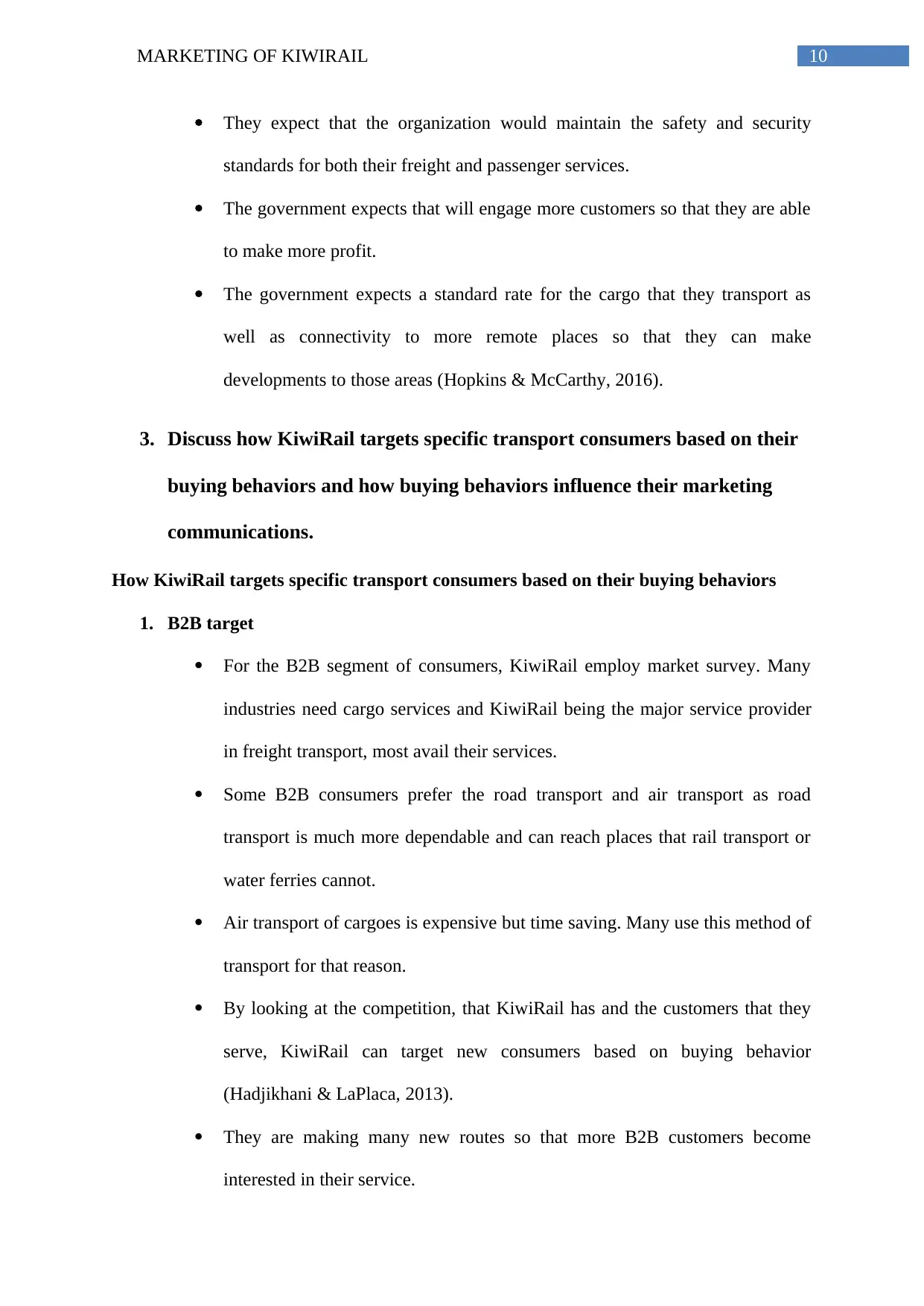
10MARKETING OF KIWIRAIL
They expect that the organization would maintain the safety and security
standards for both their freight and passenger services.
The government expects that will engage more customers so that they are able
to make more profit.
The government expects a standard rate for the cargo that they transport as
well as connectivity to more remote places so that they can make
developments to those areas (Hopkins & McCarthy, 2016).
3. Discuss how KiwiRail targets specific transport consumers based on their
buying behaviors and how buying behaviors influence their marketing
communications.
How KiwiRail targets specific transport consumers based on their buying behaviors
1. B2B target
For the B2B segment of consumers, KiwiRail employ market survey. Many
industries need cargo services and KiwiRail being the major service provider
in freight transport, most avail their services.
Some B2B consumers prefer the road transport and air transport as road
transport is much more dependable and can reach places that rail transport or
water ferries cannot.
Air transport of cargoes is expensive but time saving. Many use this method of
transport for that reason.
By looking at the competition, that KiwiRail has and the customers that they
serve, KiwiRail can target new consumers based on buying behavior
(Hadjikhani & LaPlaca, 2013).
They are making many new routes so that more B2B customers become
interested in their service.
They expect that the organization would maintain the safety and security
standards for both their freight and passenger services.
The government expects that will engage more customers so that they are able
to make more profit.
The government expects a standard rate for the cargo that they transport as
well as connectivity to more remote places so that they can make
developments to those areas (Hopkins & McCarthy, 2016).
3. Discuss how KiwiRail targets specific transport consumers based on their
buying behaviors and how buying behaviors influence their marketing
communications.
How KiwiRail targets specific transport consumers based on their buying behaviors
1. B2B target
For the B2B segment of consumers, KiwiRail employ market survey. Many
industries need cargo services and KiwiRail being the major service provider
in freight transport, most avail their services.
Some B2B consumers prefer the road transport and air transport as road
transport is much more dependable and can reach places that rail transport or
water ferries cannot.
Air transport of cargoes is expensive but time saving. Many use this method of
transport for that reason.
By looking at the competition, that KiwiRail has and the customers that they
serve, KiwiRail can target new consumers based on buying behavior
(Hadjikhani & LaPlaca, 2013).
They are making many new routes so that more B2B customers become
interested in their service.
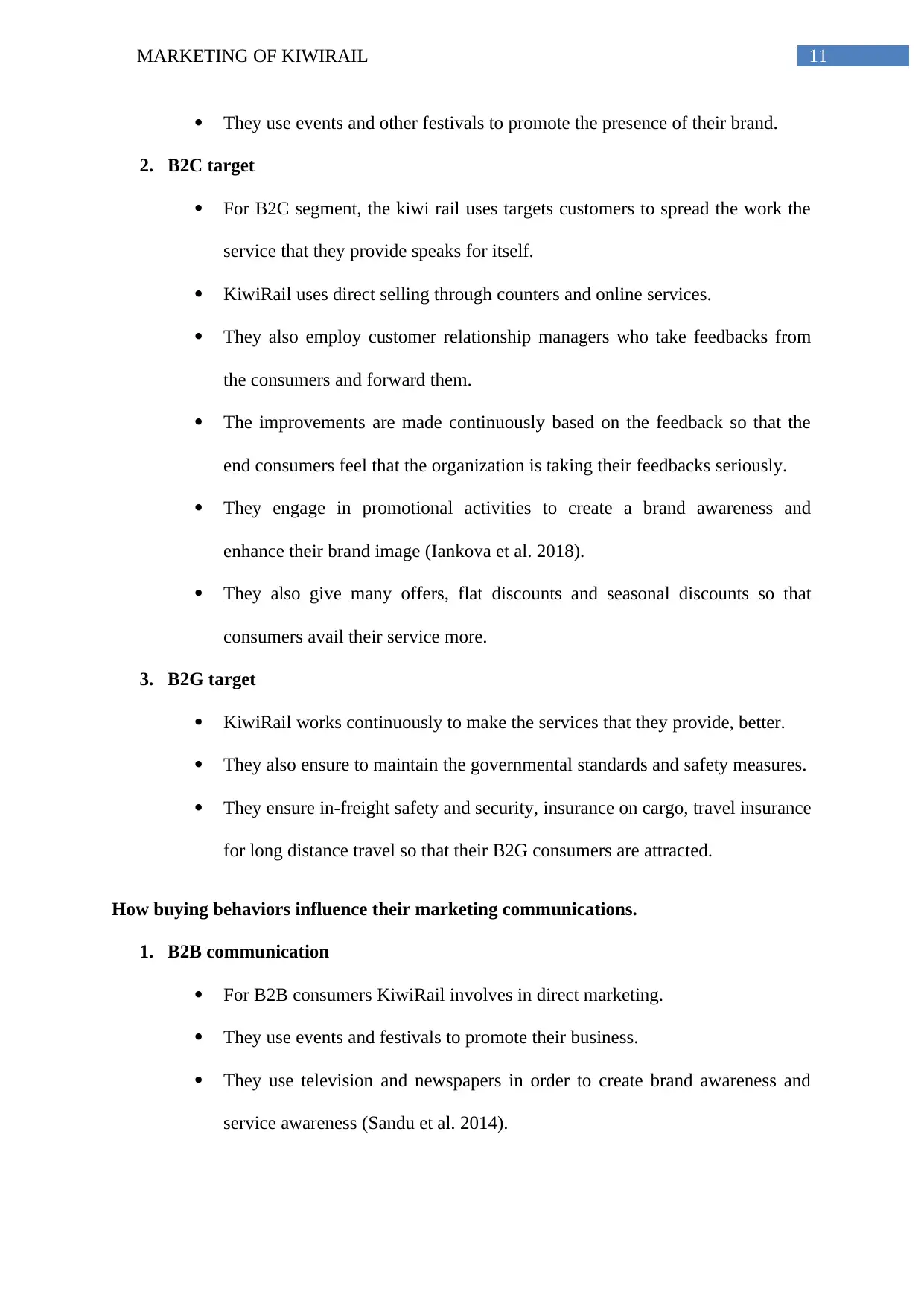
11MARKETING OF KIWIRAIL
They use events and other festivals to promote the presence of their brand.
2. B2C target
For B2C segment, the kiwi rail uses targets customers to spread the work the
service that they provide speaks for itself.
KiwiRail uses direct selling through counters and online services.
They also employ customer relationship managers who take feedbacks from
the consumers and forward them.
The improvements are made continuously based on the feedback so that the
end consumers feel that the organization is taking their feedbacks seriously.
They engage in promotional activities to create a brand awareness and
enhance their brand image (Iankova et al. 2018).
They also give many offers, flat discounts and seasonal discounts so that
consumers avail their service more.
3. B2G target
KiwiRail works continuously to make the services that they provide, better.
They also ensure to maintain the governmental standards and safety measures.
They ensure in-freight safety and security, insurance on cargo, travel insurance
for long distance travel so that their B2G consumers are attracted.
How buying behaviors influence their marketing communications.
1. B2B communication
For B2B consumers KiwiRail involves in direct marketing.
They use events and festivals to promote their business.
They use television and newspapers in order to create brand awareness and
service awareness (Sandu et al. 2014).
They use events and other festivals to promote the presence of their brand.
2. B2C target
For B2C segment, the kiwi rail uses targets customers to spread the work the
service that they provide speaks for itself.
KiwiRail uses direct selling through counters and online services.
They also employ customer relationship managers who take feedbacks from
the consumers and forward them.
The improvements are made continuously based on the feedback so that the
end consumers feel that the organization is taking their feedbacks seriously.
They engage in promotional activities to create a brand awareness and
enhance their brand image (Iankova et al. 2018).
They also give many offers, flat discounts and seasonal discounts so that
consumers avail their service more.
3. B2G target
KiwiRail works continuously to make the services that they provide, better.
They also ensure to maintain the governmental standards and safety measures.
They ensure in-freight safety and security, insurance on cargo, travel insurance
for long distance travel so that their B2G consumers are attracted.
How buying behaviors influence their marketing communications.
1. B2B communication
For B2B consumers KiwiRail involves in direct marketing.
They use events and festivals to promote their business.
They use television and newspapers in order to create brand awareness and
service awareness (Sandu et al. 2014).
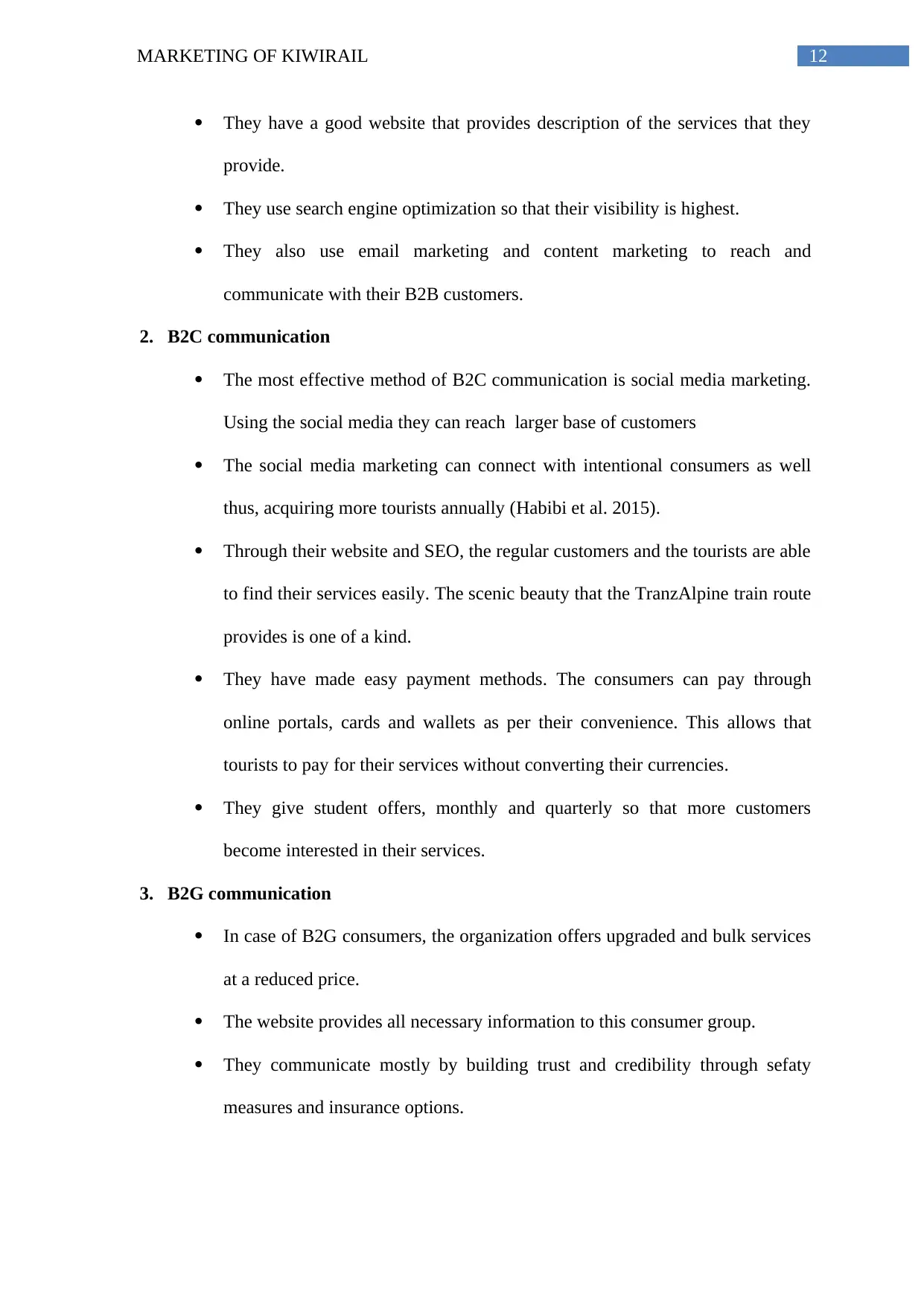
12MARKETING OF KIWIRAIL
They have a good website that provides description of the services that they
provide.
They use search engine optimization so that their visibility is highest.
They also use email marketing and content marketing to reach and
communicate with their B2B customers.
2. B2C communication
The most effective method of B2C communication is social media marketing.
Using the social media they can reach larger base of customers
The social media marketing can connect with intentional consumers as well
thus, acquiring more tourists annually (Habibi et al. 2015).
Through their website and SEO, the regular customers and the tourists are able
to find their services easily. The scenic beauty that the TranzAlpine train route
provides is one of a kind.
They have made easy payment methods. The consumers can pay through
online portals, cards and wallets as per their convenience. This allows that
tourists to pay for their services without converting their currencies.
They give student offers, monthly and quarterly so that more customers
become interested in their services.
3. B2G communication
In case of B2G consumers, the organization offers upgraded and bulk services
at a reduced price.
The website provides all necessary information to this consumer group.
They communicate mostly by building trust and credibility through sefaty
measures and insurance options.
They have a good website that provides description of the services that they
provide.
They use search engine optimization so that their visibility is highest.
They also use email marketing and content marketing to reach and
communicate with their B2B customers.
2. B2C communication
The most effective method of B2C communication is social media marketing.
Using the social media they can reach larger base of customers
The social media marketing can connect with intentional consumers as well
thus, acquiring more tourists annually (Habibi et al. 2015).
Through their website and SEO, the regular customers and the tourists are able
to find their services easily. The scenic beauty that the TranzAlpine train route
provides is one of a kind.
They have made easy payment methods. The consumers can pay through
online portals, cards and wallets as per their convenience. This allows that
tourists to pay for their services without converting their currencies.
They give student offers, monthly and quarterly so that more customers
become interested in their services.
3. B2G communication
In case of B2G consumers, the organization offers upgraded and bulk services
at a reduced price.
The website provides all necessary information to this consumer group.
They communicate mostly by building trust and credibility through sefaty
measures and insurance options.
Paraphrase This Document
Need a fresh take? Get an instant paraphrase of this document with our AI Paraphraser
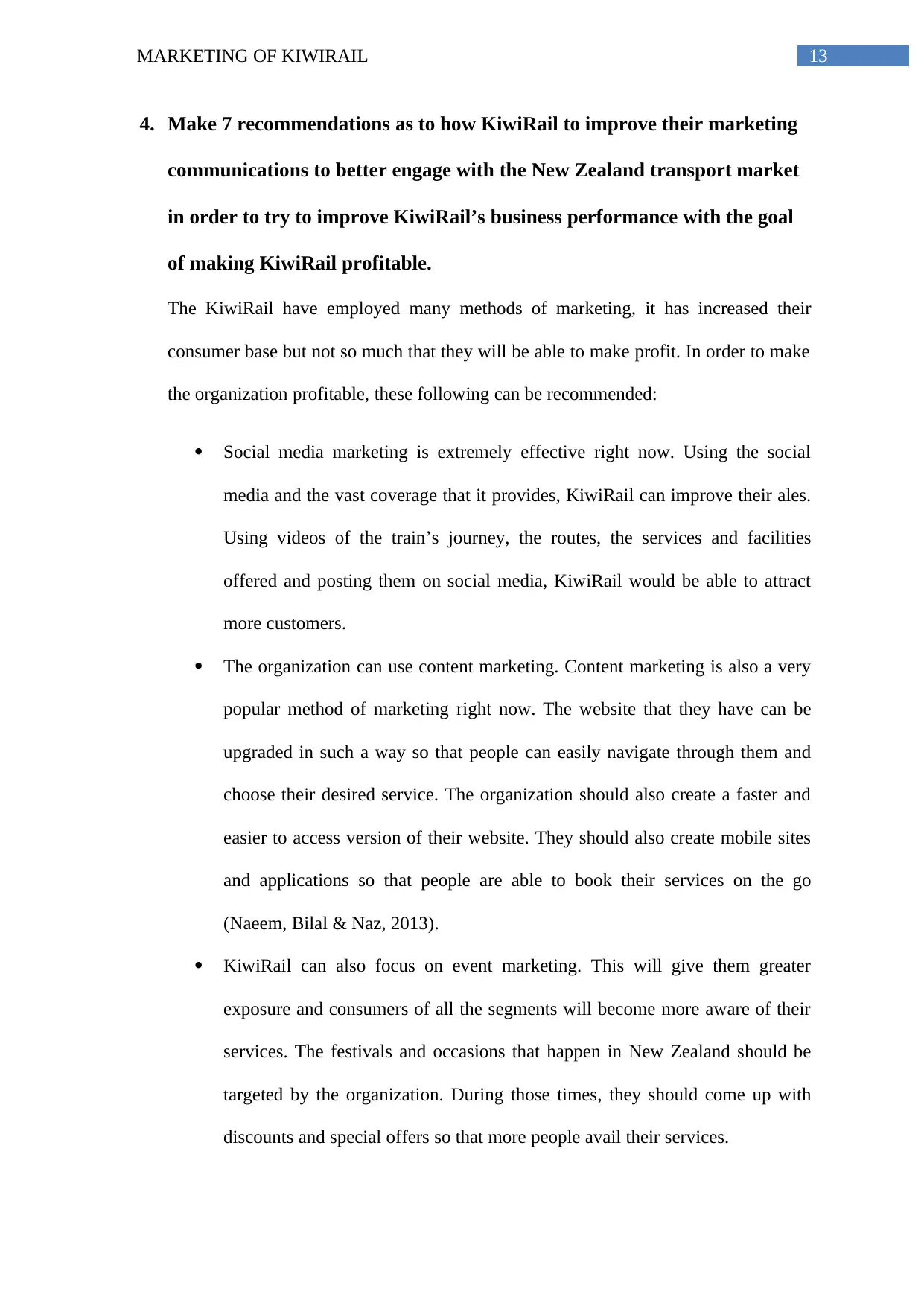
13MARKETING OF KIWIRAIL
4. Make 7 recommendations as to how KiwiRail to improve their marketing
communications to better engage with the New Zealand transport market
in order to try to improve KiwiRail’s business performance with the goal
of making KiwiRail profitable.
The KiwiRail have employed many methods of marketing, it has increased their
consumer base but not so much that they will be able to make profit. In order to make
the organization profitable, these following can be recommended:
Social media marketing is extremely effective right now. Using the social
media and the vast coverage that it provides, KiwiRail can improve their ales.
Using videos of the train’s journey, the routes, the services and facilities
offered and posting them on social media, KiwiRail would be able to attract
more customers.
The organization can use content marketing. Content marketing is also a very
popular method of marketing right now. The website that they have can be
upgraded in such a way so that people can easily navigate through them and
choose their desired service. The organization should also create a faster and
easier to access version of their website. They should also create mobile sites
and applications so that people are able to book their services on the go
(Naeem, Bilal & Naz, 2013).
KiwiRail can also focus on event marketing. This will give them greater
exposure and consumers of all the segments will become more aware of their
services. The festivals and occasions that happen in New Zealand should be
targeted by the organization. During those times, they should come up with
discounts and special offers so that more people avail their services.
4. Make 7 recommendations as to how KiwiRail to improve their marketing
communications to better engage with the New Zealand transport market
in order to try to improve KiwiRail’s business performance with the goal
of making KiwiRail profitable.
The KiwiRail have employed many methods of marketing, it has increased their
consumer base but not so much that they will be able to make profit. In order to make
the organization profitable, these following can be recommended:
Social media marketing is extremely effective right now. Using the social
media and the vast coverage that it provides, KiwiRail can improve their ales.
Using videos of the train’s journey, the routes, the services and facilities
offered and posting them on social media, KiwiRail would be able to attract
more customers.
The organization can use content marketing. Content marketing is also a very
popular method of marketing right now. The website that they have can be
upgraded in such a way so that people can easily navigate through them and
choose their desired service. The organization should also create a faster and
easier to access version of their website. They should also create mobile sites
and applications so that people are able to book their services on the go
(Naeem, Bilal & Naz, 2013).
KiwiRail can also focus on event marketing. This will give them greater
exposure and consumers of all the segments will become more aware of their
services. The festivals and occasions that happen in New Zealand should be
targeted by the organization. During those times, they should come up with
discounts and special offers so that more people avail their services.
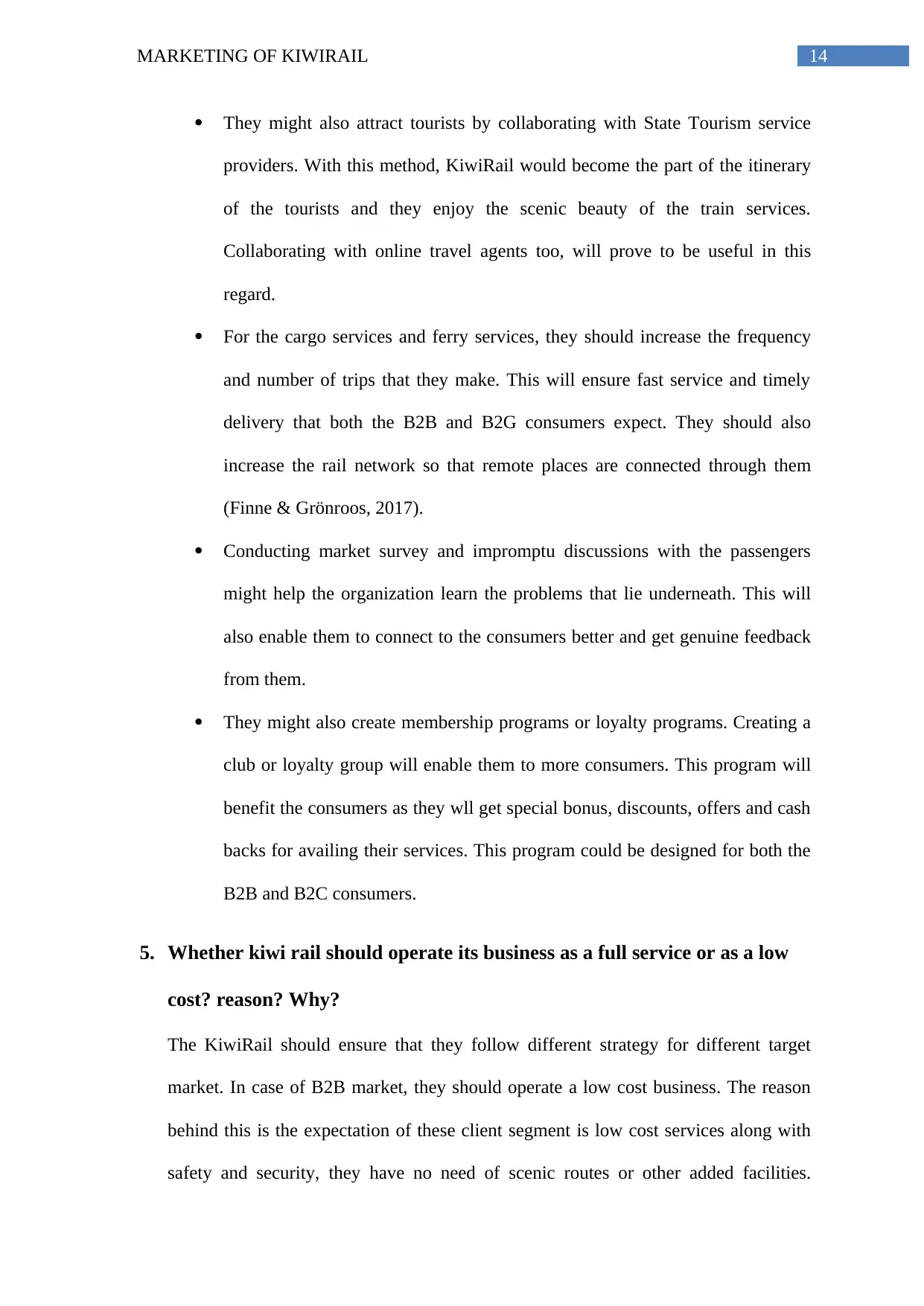
14MARKETING OF KIWIRAIL
They might also attract tourists by collaborating with State Tourism service
providers. With this method, KiwiRail would become the part of the itinerary
of the tourists and they enjoy the scenic beauty of the train services.
Collaborating with online travel agents too, will prove to be useful in this
regard.
For the cargo services and ferry services, they should increase the frequency
and number of trips that they make. This will ensure fast service and timely
delivery that both the B2B and B2G consumers expect. They should also
increase the rail network so that remote places are connected through them
(Finne & Grönroos, 2017).
Conducting market survey and impromptu discussions with the passengers
might help the organization learn the problems that lie underneath. This will
also enable them to connect to the consumers better and get genuine feedback
from them.
They might also create membership programs or loyalty programs. Creating a
club or loyalty group will enable them to more consumers. This program will
benefit the consumers as they wll get special bonus, discounts, offers and cash
backs for availing their services. This program could be designed for both the
B2B and B2C consumers.
5. Whether kiwi rail should operate its business as a full service or as a low
cost? reason? Why?
The KiwiRail should ensure that they follow different strategy for different target
market. In case of B2B market, they should operate a low cost business. The reason
behind this is the expectation of these client segment is low cost services along with
safety and security, they have no need of scenic routes or other added facilities.
They might also attract tourists by collaborating with State Tourism service
providers. With this method, KiwiRail would become the part of the itinerary
of the tourists and they enjoy the scenic beauty of the train services.
Collaborating with online travel agents too, will prove to be useful in this
regard.
For the cargo services and ferry services, they should increase the frequency
and number of trips that they make. This will ensure fast service and timely
delivery that both the B2B and B2G consumers expect. They should also
increase the rail network so that remote places are connected through them
(Finne & Grönroos, 2017).
Conducting market survey and impromptu discussions with the passengers
might help the organization learn the problems that lie underneath. This will
also enable them to connect to the consumers better and get genuine feedback
from them.
They might also create membership programs or loyalty programs. Creating a
club or loyalty group will enable them to more consumers. This program will
benefit the consumers as they wll get special bonus, discounts, offers and cash
backs for availing their services. This program could be designed for both the
B2B and B2C consumers.
5. Whether kiwi rail should operate its business as a full service or as a low
cost? reason? Why?
The KiwiRail should ensure that they follow different strategy for different target
market. In case of B2B market, they should operate a low cost business. The reason
behind this is the expectation of these client segment is low cost services along with
safety and security, they have no need of scenic routes or other added facilities.
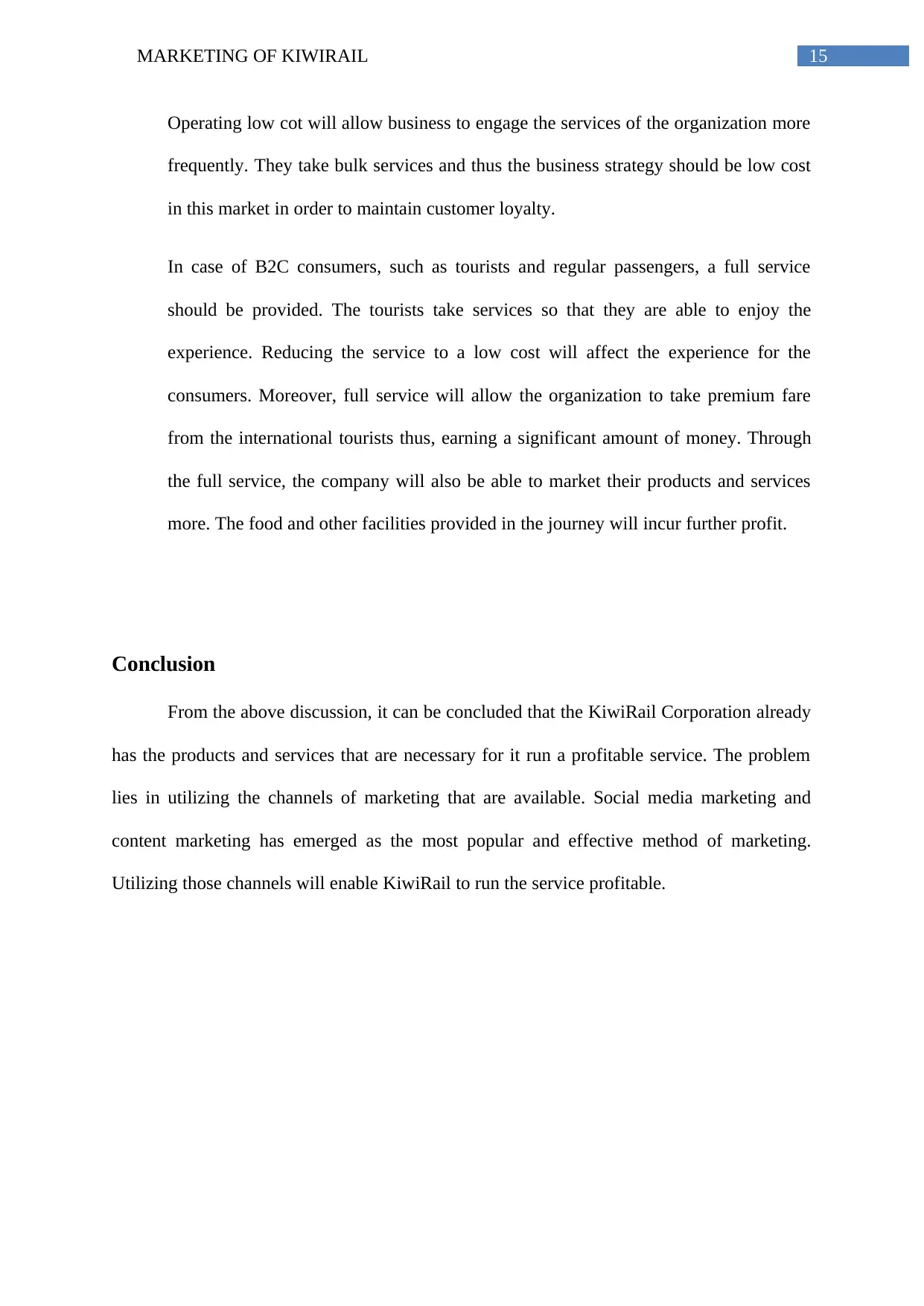
15MARKETING OF KIWIRAIL
Operating low cot will allow business to engage the services of the organization more
frequently. They take bulk services and thus the business strategy should be low cost
in this market in order to maintain customer loyalty.
In case of B2C consumers, such as tourists and regular passengers, a full service
should be provided. The tourists take services so that they are able to enjoy the
experience. Reducing the service to a low cost will affect the experience for the
consumers. Moreover, full service will allow the organization to take premium fare
from the international tourists thus, earning a significant amount of money. Through
the full service, the company will also be able to market their products and services
more. The food and other facilities provided in the journey will incur further profit.
Conclusion
From the above discussion, it can be concluded that the KiwiRail Corporation already
has the products and services that are necessary for it run a profitable service. The problem
lies in utilizing the channels of marketing that are available. Social media marketing and
content marketing has emerged as the most popular and effective method of marketing.
Utilizing those channels will enable KiwiRail to run the service profitable.
Operating low cot will allow business to engage the services of the organization more
frequently. They take bulk services and thus the business strategy should be low cost
in this market in order to maintain customer loyalty.
In case of B2C consumers, such as tourists and regular passengers, a full service
should be provided. The tourists take services so that they are able to enjoy the
experience. Reducing the service to a low cost will affect the experience for the
consumers. Moreover, full service will allow the organization to take premium fare
from the international tourists thus, earning a significant amount of money. Through
the full service, the company will also be able to market their products and services
more. The food and other facilities provided in the journey will incur further profit.
Conclusion
From the above discussion, it can be concluded that the KiwiRail Corporation already
has the products and services that are necessary for it run a profitable service. The problem
lies in utilizing the channels of marketing that are available. Social media marketing and
content marketing has emerged as the most popular and effective method of marketing.
Utilizing those channels will enable KiwiRail to run the service profitable.
Secure Best Marks with AI Grader
Need help grading? Try our AI Grader for instant feedback on your assignments.
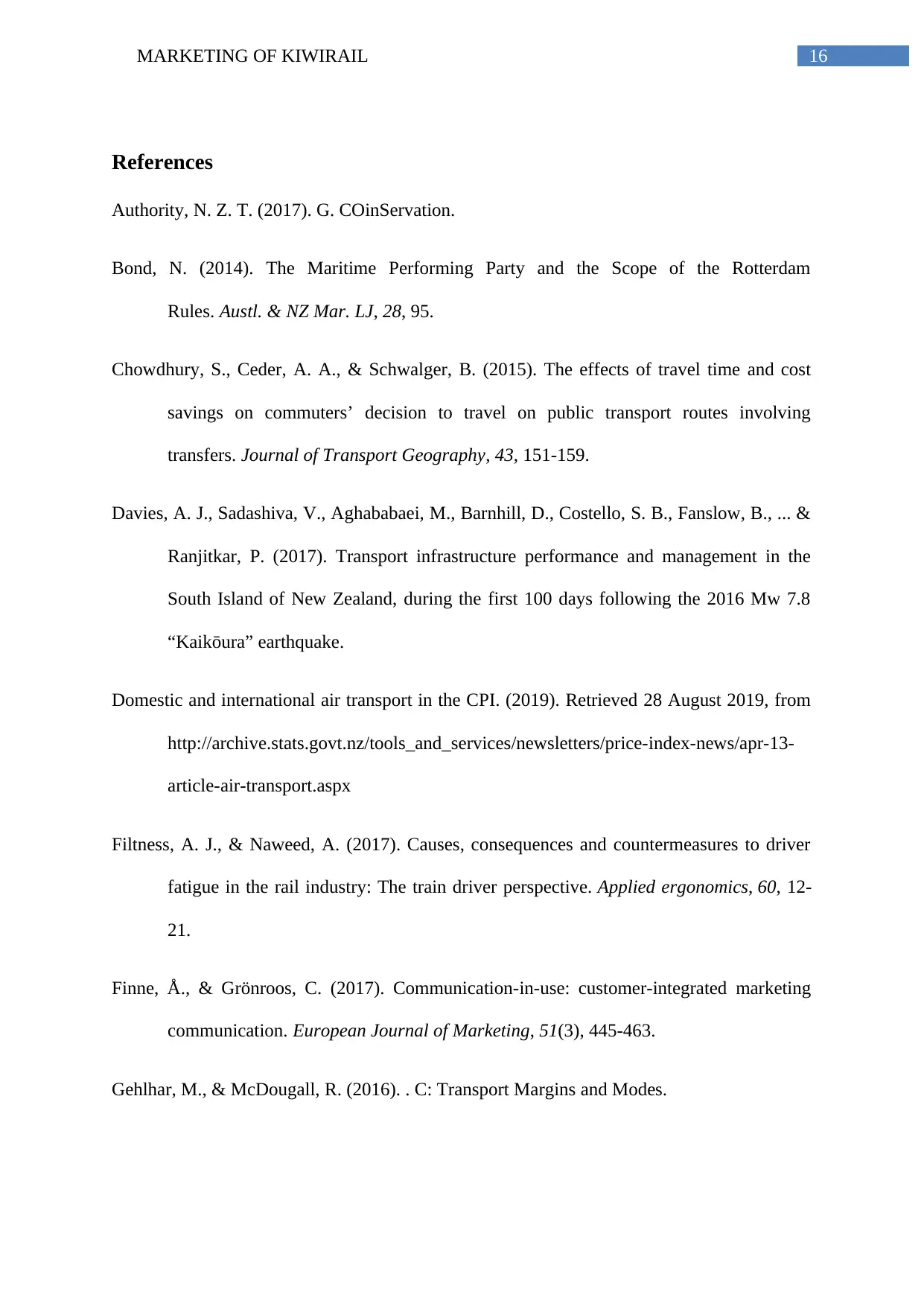
16MARKETING OF KIWIRAIL
References
Authority, N. Z. T. (2017). G. COinServation.
Bond, N. (2014). The Maritime Performing Party and the Scope of the Rotterdam
Rules. Austl. & NZ Mar. LJ, 28, 95.
Chowdhury, S., Ceder, A. A., & Schwalger, B. (2015). The effects of travel time and cost
savings on commuters’ decision to travel on public transport routes involving
transfers. Journal of Transport Geography, 43, 151-159.
Davies, A. J., Sadashiva, V., Aghababaei, M., Barnhill, D., Costello, S. B., Fanslow, B., ... &
Ranjitkar, P. (2017). Transport infrastructure performance and management in the
South Island of New Zealand, during the first 100 days following the 2016 Mw 7.8
“Kaikōura” earthquake.
Domestic and international air transport in the CPI. (2019). Retrieved 28 August 2019, from
http://archive.stats.govt.nz/tools_and_services/newsletters/price-index-news/apr-13-
article-air-transport.aspx
Filtness, A. J., & Naweed, A. (2017). Causes, consequences and countermeasures to driver
fatigue in the rail industry: The train driver perspective. Applied ergonomics, 60, 12-
21.
Finne, Å., & Grönroos, C. (2017). Communication-in-use: customer-integrated marketing
communication. European Journal of Marketing, 51(3), 445-463.
Gehlhar, M., & McDougall, R. (2016). . C: Transport Margins and Modes.
References
Authority, N. Z. T. (2017). G. COinServation.
Bond, N. (2014). The Maritime Performing Party and the Scope of the Rotterdam
Rules. Austl. & NZ Mar. LJ, 28, 95.
Chowdhury, S., Ceder, A. A., & Schwalger, B. (2015). The effects of travel time and cost
savings on commuters’ decision to travel on public transport routes involving
transfers. Journal of Transport Geography, 43, 151-159.
Davies, A. J., Sadashiva, V., Aghababaei, M., Barnhill, D., Costello, S. B., Fanslow, B., ... &
Ranjitkar, P. (2017). Transport infrastructure performance and management in the
South Island of New Zealand, during the first 100 days following the 2016 Mw 7.8
“Kaikōura” earthquake.
Domestic and international air transport in the CPI. (2019). Retrieved 28 August 2019, from
http://archive.stats.govt.nz/tools_and_services/newsletters/price-index-news/apr-13-
article-air-transport.aspx
Filtness, A. J., & Naweed, A. (2017). Causes, consequences and countermeasures to driver
fatigue in the rail industry: The train driver perspective. Applied ergonomics, 60, 12-
21.
Finne, Å., & Grönroos, C. (2017). Communication-in-use: customer-integrated marketing
communication. European Journal of Marketing, 51(3), 445-463.
Gehlhar, M., & McDougall, R. (2016). . C: Transport Margins and Modes.
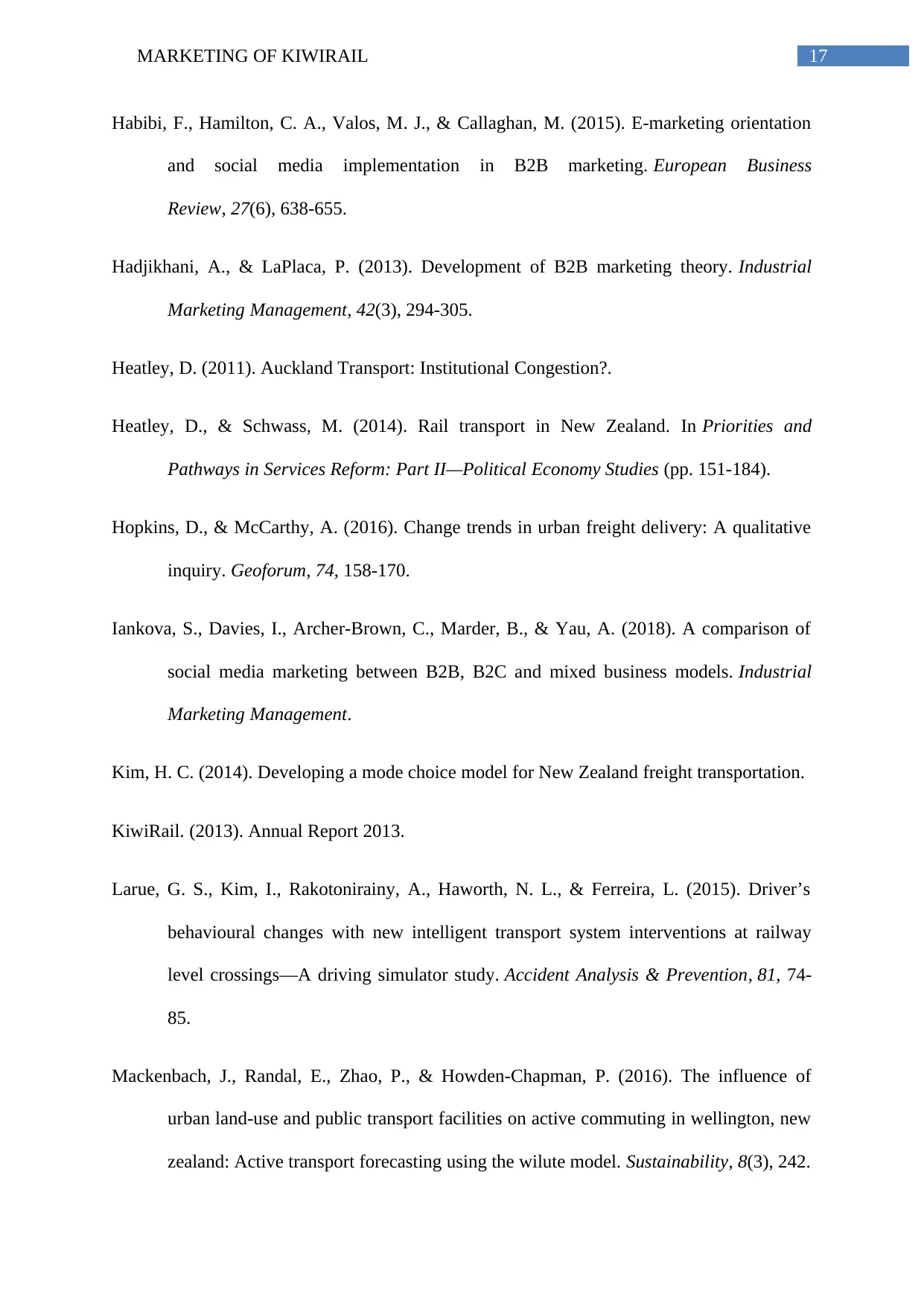
17MARKETING OF KIWIRAIL
Habibi, F., Hamilton, C. A., Valos, M. J., & Callaghan, M. (2015). E-marketing orientation
and social media implementation in B2B marketing. European Business
Review, 27(6), 638-655.
Hadjikhani, A., & LaPlaca, P. (2013). Development of B2B marketing theory. Industrial
Marketing Management, 42(3), 294-305.
Heatley, D. (2011). Auckland Transport: Institutional Congestion?.
Heatley, D., & Schwass, M. (2014). Rail transport in New Zealand. In Priorities and
Pathways in Services Reform: Part II—Political Economy Studies (pp. 151-184).
Hopkins, D., & McCarthy, A. (2016). Change trends in urban freight delivery: A qualitative
inquiry. Geoforum, 74, 158-170.
Iankova, S., Davies, I., Archer-Brown, C., Marder, B., & Yau, A. (2018). A comparison of
social media marketing between B2B, B2C and mixed business models. Industrial
Marketing Management.
Kim, H. C. (2014). Developing a mode choice model for New Zealand freight transportation.
KiwiRail. (2013). Annual Report 2013.
Larue, G. S., Kim, I., Rakotonirainy, A., Haworth, N. L., & Ferreira, L. (2015). Driver’s
behavioural changes with new intelligent transport system interventions at railway
level crossings—A driving simulator study. Accident Analysis & Prevention, 81, 74-
85.
Mackenbach, J., Randal, E., Zhao, P., & Howden-Chapman, P. (2016). The influence of
urban land-use and public transport facilities on active commuting in wellington, new
zealand: Active transport forecasting using the wilute model. Sustainability, 8(3), 242.
Habibi, F., Hamilton, C. A., Valos, M. J., & Callaghan, M. (2015). E-marketing orientation
and social media implementation in B2B marketing. European Business
Review, 27(6), 638-655.
Hadjikhani, A., & LaPlaca, P. (2013). Development of B2B marketing theory. Industrial
Marketing Management, 42(3), 294-305.
Heatley, D. (2011). Auckland Transport: Institutional Congestion?.
Heatley, D., & Schwass, M. (2014). Rail transport in New Zealand. In Priorities and
Pathways in Services Reform: Part II—Political Economy Studies (pp. 151-184).
Hopkins, D., & McCarthy, A. (2016). Change trends in urban freight delivery: A qualitative
inquiry. Geoforum, 74, 158-170.
Iankova, S., Davies, I., Archer-Brown, C., Marder, B., & Yau, A. (2018). A comparison of
social media marketing between B2B, B2C and mixed business models. Industrial
Marketing Management.
Kim, H. C. (2014). Developing a mode choice model for New Zealand freight transportation.
KiwiRail. (2013). Annual Report 2013.
Larue, G. S., Kim, I., Rakotonirainy, A., Haworth, N. L., & Ferreira, L. (2015). Driver’s
behavioural changes with new intelligent transport system interventions at railway
level crossings—A driving simulator study. Accident Analysis & Prevention, 81, 74-
85.
Mackenbach, J., Randal, E., Zhao, P., & Howden-Chapman, P. (2016). The influence of
urban land-use and public transport facilities on active commuting in wellington, new
zealand: Active transport forecasting using the wilute model. Sustainability, 8(3), 242.
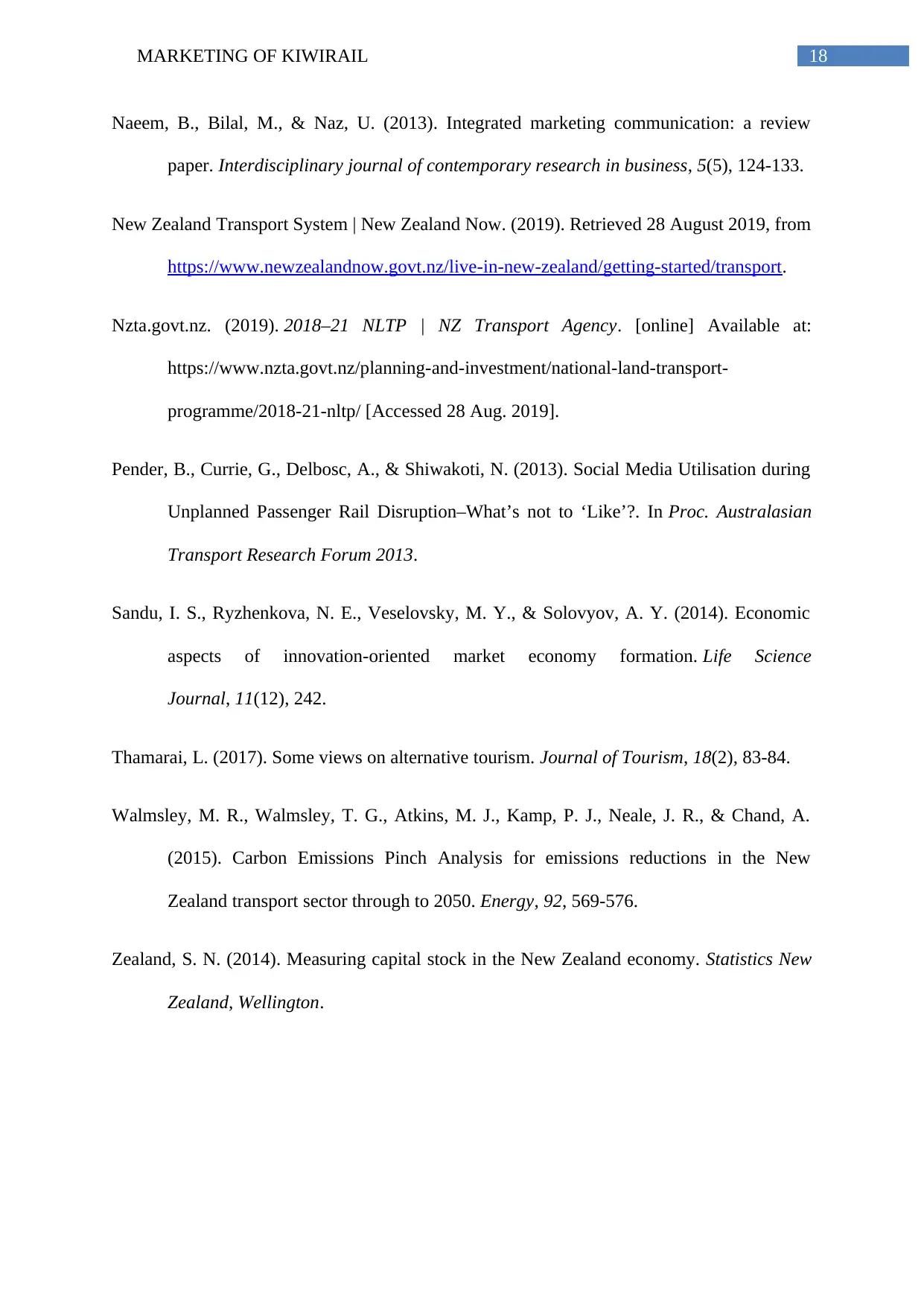
18MARKETING OF KIWIRAIL
Naeem, B., Bilal, M., & Naz, U. (2013). Integrated marketing communication: a review
paper. Interdisciplinary journal of contemporary research in business, 5(5), 124-133.
New Zealand Transport System | New Zealand Now. (2019). Retrieved 28 August 2019, from
https://www.newzealandnow.govt.nz/live-in-new-zealand/getting-started/transport.
Nzta.govt.nz. (2019). 2018–21 NLTP | NZ Transport Agency. [online] Available at:
https://www.nzta.govt.nz/planning-and-investment/national-land-transport-
programme/2018-21-nltp/ [Accessed 28 Aug. 2019].
Pender, B., Currie, G., Delbosc, A., & Shiwakoti, N. (2013). Social Media Utilisation during
Unplanned Passenger Rail Disruption–What’s not to ‘Like’?. In Proc. Australasian
Transport Research Forum 2013.
Sandu, I. S., Ryzhenkova, N. E., Veselovsky, M. Y., & Solovyov, A. Y. (2014). Economic
aspects of innovation-oriented market economy formation. Life Science
Journal, 11(12), 242.
Thamarai, L. (2017). Some views on alternative tourism. Journal of Tourism, 18(2), 83-84.
Walmsley, M. R., Walmsley, T. G., Atkins, M. J., Kamp, P. J., Neale, J. R., & Chand, A.
(2015). Carbon Emissions Pinch Analysis for emissions reductions in the New
Zealand transport sector through to 2050. Energy, 92, 569-576.
Zealand, S. N. (2014). Measuring capital stock in the New Zealand economy. Statistics New
Zealand, Wellington.
Naeem, B., Bilal, M., & Naz, U. (2013). Integrated marketing communication: a review
paper. Interdisciplinary journal of contemporary research in business, 5(5), 124-133.
New Zealand Transport System | New Zealand Now. (2019). Retrieved 28 August 2019, from
https://www.newzealandnow.govt.nz/live-in-new-zealand/getting-started/transport.
Nzta.govt.nz. (2019). 2018–21 NLTP | NZ Transport Agency. [online] Available at:
https://www.nzta.govt.nz/planning-and-investment/national-land-transport-
programme/2018-21-nltp/ [Accessed 28 Aug. 2019].
Pender, B., Currie, G., Delbosc, A., & Shiwakoti, N. (2013). Social Media Utilisation during
Unplanned Passenger Rail Disruption–What’s not to ‘Like’?. In Proc. Australasian
Transport Research Forum 2013.
Sandu, I. S., Ryzhenkova, N. E., Veselovsky, M. Y., & Solovyov, A. Y. (2014). Economic
aspects of innovation-oriented market economy formation. Life Science
Journal, 11(12), 242.
Thamarai, L. (2017). Some views on alternative tourism. Journal of Tourism, 18(2), 83-84.
Walmsley, M. R., Walmsley, T. G., Atkins, M. J., Kamp, P. J., Neale, J. R., & Chand, A.
(2015). Carbon Emissions Pinch Analysis for emissions reductions in the New
Zealand transport sector through to 2050. Energy, 92, 569-576.
Zealand, S. N. (2014). Measuring capital stock in the New Zealand economy. Statistics New
Zealand, Wellington.
1 out of 19
Related Documents
Your All-in-One AI-Powered Toolkit for Academic Success.
+13062052269
info@desklib.com
Available 24*7 on WhatsApp / Email
![[object Object]](/_next/static/media/star-bottom.7253800d.svg)
Unlock your academic potential
© 2024 | Zucol Services PVT LTD | All rights reserved.





